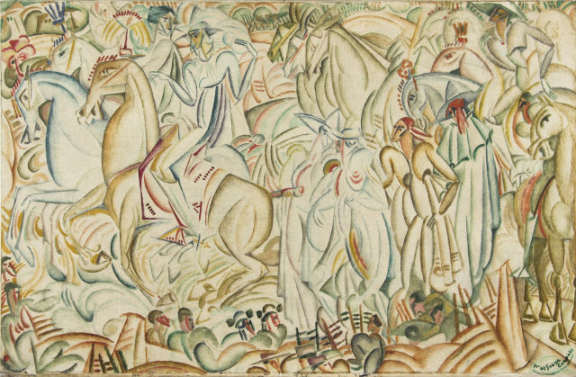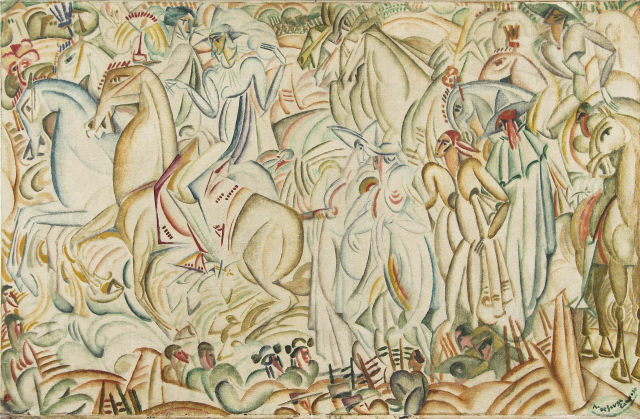
- 1912
- Canvas
- Oil
- Inv. 06P1267
Amadeo de Souza-Cardoso
Avant la corrida
Presented among cubist paintings at the X Salon d’Automne (Paris, 1912) before being taken to the Armory Show (1913), where it was chosen to be one of the postcards sold to the public and used for publicity in the media, Avant la Corrida can be seen as Amadeo's response to the emergence of cubism and futurism. In seeking to refresh his personal thematic world of cavalcades by geometrizing the whole in a mannerist, graphically saturated style analogous to Le Prince et la Meute and Don Quixote, he creates a paradoxical cubo-futurist vision which, being based on the dynamic decomposition of speed, has parallels with other pioneering works created in the same year, particularly the painting near which it was exhibited in Chicago, Marcel Duchamp's Nu descendant l’escalier,* and likewise counterposing the static nature of cubism without adhering to the doctrinaire principles of futurism, as one the first modernist attempts to capture motion by pictorial means.**
Avant la Corrida deliberately complicates the legibility of the titular theme in favour of enhancing the sense of pictorial play, which is marked by the dynamic strength of curved or oblique lines, rendered like cuts in the canvas, creating an effect of successive waves that stands in contrast to the angular nature of orthodox cubism. Amadeo's formal, methodical deconstruction, characterised by a rhythmically peculiar arrangement, gives rise to shadowy, abstract planes that suggest action and imbue the figures with depth and volume despite their static positions. The tumult of the crowd before the bullfight is thereby mixed up in the flat spatiality of the work, although Amadeo’s traditional frame is maintained: in the foreground, seated figures watch the procession; in the background, hints of a rural landscape can be seen; while the central group of elements, fragmented and dispersed in a mesh of lines, illustrates social diversity, with clothes and hats of different styles, faces sketched like African masks, reduced to a minimum of expression, and eyes looking in every direction in the frenzy of the forthcoming bullfight.
The sophistication of these kinetic visual solutions is therefore passed through the prism of popular culture, exploring festivals and folklore with a vitality that was unique among the works surrounding it, eschewing the monochrome nature of cubism with an original range of earthy colours, surgically applied to the dominant white background, and schematically drawn green, blue and yellow horses, slender and eclectic in various poses, disorientating critics who saw them as decorative and exotic hieroglyphs.
Avant la corrida was bought by the painter Robert Winthrop Chanler only nine days after the Armory Show opened in New York. Despite its initial success and the leading role that it played, this canvas was not relocated until a century later, in 2006, when the Calouste Gulbenkian Foundation immediately bought and exhibited it, at the exhibition Avant-Garde Dialogue.
Afonso Ramos
July 2013
* Seeing the paintings that were in the same room at the Armory Show in Chicago, the renowned American painter Manierre Dawson coincidently bought the study for this Nu by Marcel Duchamp (1912) and Return from the Chase (1911) by Amadeo. However, he could not afford the third work that he judged to be among the best of those still on sale, Picasso's La Femme au pot de moutarde (1910).
**Amadeo, who attended the first futurist exhibition in Paris, belonged to a circle of friends that included Boccioni and Carrà, artists who also created their iconic works on the figuration of movement in 1912.
*** Besides this painting, which, at 800 francs, was the most expensive of the seven works that Amadeo sold at the Armory Show, the American artist who bought it (who saw parallels between his own work and that of the Portuguese artist) also purchased a watercolour, Marine, for 50 francs.
| Type | Value | Unit | Section |
| Height | 60 | cm | |
| Width | 92 | cm |
| Type | signed |
| Type | Acquisition |
| International Exhibition of Modern Art |
| Chicago, The Art Institute of Chicago, 1913 |
| Catálogo |
| The story of the Armory Show |
| New York, Abbeville Press, 1988 |
| Monografia |
| Salon d'Automne: Catalogue des ouvrages de peinture, sculpture, dessin |
| Paris, Kugelmann, 1912 |
| Catálogo |
| Amadeo de Souza-Cardoso: diálogo de vanguardas |
| Lisboa, Fundação Calouste Gulbenkian. Centro de Arte Moderna José de Azeredo Perdigão, Assírio & Alvim, 2006 |
| Catálogo |
| Amadeo de Souza-Cardoso: diálogo de vanguardas |
| Lisboa, Fundação Calouste Gulbenkian. Centro de Arte Moderna José de Azeredo Perdigão, Assírio & Alvim, 2006 |
| Catálogo |
| Amadeo de Souza-Cardoso: Fotobiografia: Catálogo raisonné. Vol. I |
| Lisboa, Centro de Arte Moderna José de Azeredo Perdigão, Fundação Calouste Gulbenkian; Assírio & Alvim, 2007 |
| Monografia |
| Amadeo de Souza-Cardoso (1887-1918): Ein pionier aus Portugal |
| Hamburg, Ernst Barlach Haus, 2007 |
| Catálogo |
| International Exhibition of Modern Art, Under the Auspices of Association of American Painters and Sculptors |
| Boston, Copley Society of Boston, 1913 |
| Catálogo |
| International Exhibition of Modern Art (Armory Show) |
| 17 de Fevereiro a 15 de Março de 1913 Armory of the 69th Infantry |
| 24 de Março a 16 de Abril de 1913 The Art Institute of Chicago |
| 28 de Abril a 18 de Maio de 1913 Copley Hall |
| Exposição realizada em New York, Chicago e Boston. |
| X Salon dAutomne |
| 1 de Outubro a 8 de Novembro de 1912 Grand Palais des Champs Elysées |
| Amadeo expôs 3 obras. |
| Amadeo de Souza-Cardoso: diálogo de vanguardas |
| Curator: FREITAS, Helena de |
| 15 de Novembro de 2006 a 15 de Janeiro de 2007 Fundação Calouste Gulbenkian |
| Integra 193 obras de Amadeo e 77 obras de artistas internacionais. |
| Amadeo de Souza-Cardoso (1887-1918): Ein pionier aus Portugal |
| 2 de Dezembro de 2007 a 30 Março de 2008 Ernst Barlach Haus |
| Apresentou 66 obras de Amadeo. |
